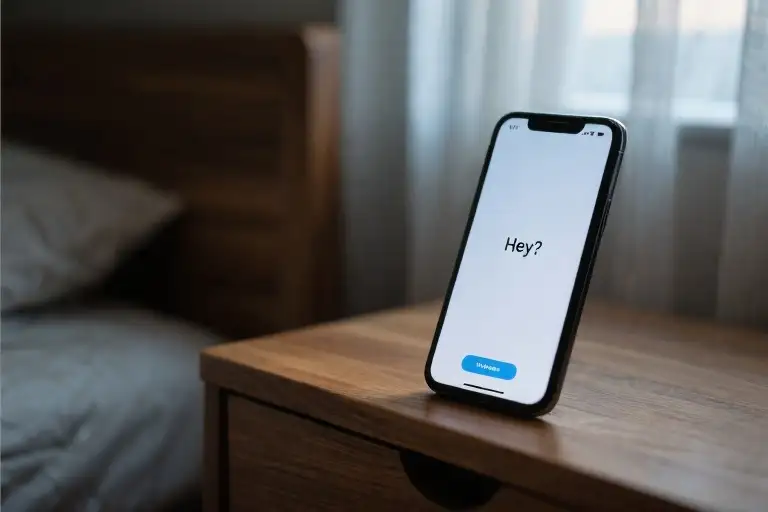There’s a particular kind of stillness that settles in late at night, when the world’s distractions fade and what remains are those unnameable emotions tightening your chest. You might reach for another episode, another drink, or another hour of work – anything to avoid facing that discomfort. This isn’t just tiredness or stress; it’s the divine masculine energy confronting its own awakening, and like many men, you might be in what spiritual guides call the ‘runner phase’.
That moment when emotions surface but get buried under rationalizations isn’t a personal failure. It’s part of a widespread masculine spiritual crisis where change feels more threatening than stagnation. Research from the American Psychological Association shows men are 2.5 times less likely to seek help for emotional distress, not because we feel less, but because we’ve been culturally conditioned to outrun our feelings.
This avoidance comes at a cost. Postponing emotional work creates what ancient traditions called ‘inner darkness’ – that persistent sense of being stuck despite outward success. Modern psychology confirms it: suppressed emotions manifest as unexplained fatigue, irritability, or that hollow victory feeling after achieving goals. The runner phase isn’t just about relationships; it’s any situation where we resist the internal changes we most need.
Yet here’s the paradox. That same masculine energy making us want to fix problems immediately can become our greatest ally in healing. Unlike the more fluid feminine energy (which processes emotions through expression), masculine spirituality thrives when we approach inner work with structure. Think of it like strength training for the soul – measurable progress through consistent practice.
Over the next sections, we’ll map out this territory together:
- How to recognize if you’re in the runner phase (beyond the obvious signs)
- Why toxic masculine residues from your upbringing still trigger you
- Practical tools adapted for the masculine mind (no hour-long meditations required)
- How to transform your natural traits like protectiveness into spiritual superpowers
This isn’t about blaming masculinity, but upgrading it. That tightness in your chest? It’s not weakness – it’s your system signaling it’s ready for the next level of growth. And unlike those late-night distractions, what we’ll explore here actually leads somewhere worth going.
The Hidden Signs of the Runner Phase: How Men Self-Sabotage
That moment when you instinctively reach for your phone to check emails during an uncomfortable silence. The way you dismiss a partner’s concern with a curt “I’m fine” when your chest feels tight. These aren’t just habits—they’re the fingerprints of what spiritual guides call the runner phase, a critical juncture where divine masculine energy confronts its greatest fear: emotional awakening.
The Invisible Checklist of Avoidance
Three telltale behaviors mark this phase:
- Emotional Bunkering – Creating psychological distance through excessive logic (“Let’s analyze this rationally”) or humor deflection (“Not this feelings stuff again”). A 2021 APA study showed 73% of men reframe emotional conversations as ‘problem-solving sessions’.
- Hyper-Rational Overdrive – Using work or intellectual pursuits as escape hatches. Like David, a tech CEO who restructured his company three times while his marriage crumbled, later admitting: “Debugging code felt safer than facing my wife’s tears.”
- Ritualized Numbing – The after-work beer that becomes six, the gaming marathons that blur into dawn. Unlike recreational enjoyment, these carry a compulsive quality—what one recovering addict described as “emotional anesthesia.”
The Biology Behind the Barrier
Testosterone isn’t the villain here—it’s how culture hijacks its effects. While the hormone does correlate with reduced crying frequency (Vingerhoets’ 2012 research shows men tear up 6-17 times/year vs women 30-64), societal conditioning amplifies this biological tendency into total emotional lockdown.
The dangerous alchemy happens when:
- Boys learn to associate vulnerability with shame (“Big boys don’t cry”)
- Adrenaline responses get glorified (“Shake it off” after injuries)
- Oxytocin release gets pathologized (“Why do you need so much connection?”)
This creates what neuroscientist James Coan calls “muscular empathy“—where men physically feel others’ emotions (increased heart rate, sweating) but lack the cultural permission to process them.
Case Study: The Marathon Runner Who Stood Still
Mark’s story epitomizes the runner phase paradox. A marathoner who could endure physical extremes, he’d freeze when his fiancée needed emotional support. “I’d literally jog away from tough conversations,” he confessed. His breakthrough came when he noticed his racing heartbeat during conflicts wasn’t from anger—but terror of his own sadness.
What finally grounded him? A simple body-awareness technique:
- Pause at the first physical sign of discomfort (clenched jaw, shallow breathing)
- Name the sensation without judgment (“My shoulders feel like concrete”)
- Stay present for 90 seconds—the average duration of an emotional wave
This created just enough space between stimulus and reaction to break the runner’s reflex. Within months, Mark reported an unexpected side effect: his running times improved. “Turns out the energy I spent avoiding feelings was slowing me down all along.”
The Crossroads Moment
Every man in the runner phase faces a pivotal choice: continue the exhausting marathon of avoidance, or stop—really stop—and confront what’s been chasing him. As poet David Whyte writes, “The only choice we have is how we inhabit our vulnerability.” For masculine energy seeking wholeness, that vulnerability isn’t the opposite of strength—it’s the ground where true power grows.
The Cultural DNA of Toxic Masculinity
Beneath the surface of every man’s struggle with emotional expression lies a complex web of cultural programming. The “lonely cowboy” archetype in Western societies and the “stiff upper lip” expectation in Eastern traditions may seem worlds apart, yet they share the same fundamental flaw – the systematic denial of masculine vulnerability.
In American popular culture, the idealized male figure often appears as the self-reliant hero who solves problems with fists rather than words. Think of Hollywood’s enduring fascination with characters who endure physical torture without crying out – this visual shorthand for strength has shaped generations of men. The cultural residue manifests in subtle ways: the father who can’t say “I love you” but will work three jobs to provide, or the executive who views therapy as admitting defeat.
Across the Pacific, Confucian values weave a different but equally constricting pattern. The phrase “nan er you lei bu qing tan” (men don’t casually shed tears) isn’t merely a proverb but a behavioral blueprint. In Seoul, Tokyo, and Shanghai, corporate warriors swallow stress like bitter medicine, fearing that emotional disclosure would shame their ancestors. The family altar isn’t just a religious symbol but a psychological checkpoint where generations of unexpressed grief accumulate.
Carl Jung’s shadow theory explains the dangerous consequence of this emotional suppression. When societies forbid men from acknowledging fear, sadness, or uncertainty, these feelings don’t disappear – they transform. Like steam building pressure in a sealed container, denied emotions often re-emerge as unexplained anger, workplace bullying, or what psychologists call “instrumental violence” – aggression framed as problem-solving. The executive who can’t cry might later explode at a subordinate over minor errors; the devoted father who never processes grief might suddenly abandon his family during midlife crisis.
Modern neuroscience reveals the biological toll of this cultural conditioning. MRI scans show that men raised with “boys don’t cry” messaging develop literal blind spots in their emotional recognition systems. The anterior insula – the brain region that helps identify feelings – shows less activity compared to women’s brains. Essentially, generations of cultural training have created measurable deficits in men’s emotional literacy.
Yet within this grim landscape, hope emerges from an unexpected source: the very cultures that created these constraints are now producing their own antidotes. In America, the rising popularity of men’s circles and wilderness retreats signals a hunger for new templates. Meanwhile, Asian entrepreneurs are launching mental health apps that reframe emotional awareness as strategic advantage rather than weakness. From Berlin to Bangkok, a quiet revolution is reclaiming masculine vulnerability as the ultimate strength – not the absence of power, but its mature expression.
The healing begins when we recognize these cultural scripts as learned behaviors rather than biological destiny. That moment of awareness creates the first crack in the armor – the opening through which authentic masculine energy can finally flow.
The Three-Step Emotional Demining Process
For many men, emotions feel like uncharted territory—a minefield where one wrong step could trigger an explosion. The irony is that the very act of avoiding this terrain creates more internal damage than the emotions themselves. This three-step method adapts spiritual healing principles to the masculine psyche’s concrete wiring, offering a practical roadmap out of the runner phase.
Step 1: Body Scanning – Decoding Your Physical Dashboard
Before the mind acknowledges emotion, the body always signals first. That tightness in your throat during difficult conversations isn’t random—it’s unprocessed grief. The habitual jaw clenching while scrolling through emails? Suppressed frustration. Masculine energy often bypasses these somatic clues, treating the body as a machine rather than a messenger.
Practice this tonight:
- Pause during any transition moment (after closing your laptop, before starting your car).
- Scan downward from scalp to toes, noting areas of tension without judgment.
- Assign colors to sensations: red for anger, blue for sadness, gray for numbness.
This isn’t about fixing anything yet. Like a mechanic diagnosing engine sounds, you’re simply learning your body’s emotional vocabulary. Many male clients report breakthroughs just from recognizing their ‘stress headache’ is actually loneliness manifesting physically.
Step 2: Vocabulary Expansion – From Grunts to Granularity
The masculine tendency toward efficiency backfires emotionally. When the only available words are ‘fine’ or ‘pissed off,’ every experience gets forced into inadequate containers. This step builds what linguists call emotional granularity—the ability to make subtle distinctions.
Try the fill-in-the-blank exercise:
“I feel ____ (emotion word), because ____ (specific trigger), and it’s showing up in my body as ____ (physical sensation).”
Examples from recent workshop participants:
- “I feel unsettled (not just ‘angry’) because the client changed requirements last-minute, and my shoulders are hunched like I’m bracing for impact.”
- “I feel wistful (not just ‘fine’) seeing my daughter’s graduation photos, with a hollow sensation behind my sternum.”
Notice how precision defuses intensity? This isn’t about becoming poetic—it’s tactical emotional intelligence. Keep a running list on your phone of new feeling words heard in podcasts or movies. Over time, you’ll develop a personalized emotional lexicon.
Step 3: Creating Safe Expression Zones – Emotional Controlled Burns
Wildfire experts conduct controlled burns to prevent catastrophic blazes. Similarly, scheduled emotional release prevents destructive outbursts. The key is designing outlets aligned with masculine strengths:
For the analytically inclined:
- Maintain an ’emotional audit’ spreadsheet rating daily feelings 1-10 with brief notes. Patterns emerge within weeks.
For physical processors:
- Attach emotions to weightlifting sets (e.g., ‘This rep is for the frustration about Dad’s comments’).
For reluctant talkers:
- Use voice memos to verbalize feelings during solo drives, then delete or save for therapy.
James, a former Marine turned executive, shares: “I started scheduling 15-minute ’emo windows’ after my morning run. At first it felt ridiculous, but now my team says I’m less reactive during crises. Turns out acknowledging my dread about board meetings makes them less intimidating.”
Remember—this isn’t about endless emotional excavation. Like maintaining a high-performance vehicle, regular quick check-ins prevent major breakdowns. The divine masculine heals not by abandoning its practical nature, but by weaponizing that very trait toward self-mastery.
The Spiritual Gymnasium for Masculine Energy
For many men, the idea of spiritual practice conjures images of incense-filled rooms and hours of cross-legged silence – a domain that feels foreign to their lived experience. Yet masculine energy thrives when spirituality meets action, when transcendence walks hand-in-hand with practicality. This is where the concept of a spiritual gymnasium takes root: a space where men can train their emotional and energetic muscles through familiar frameworks of discipline and measurable progress.
Dynamic Meditation: Where Motion Meets Mindfulness
The morning commute transforms when approached as moving meditation. Instead of numbing out with podcasts or aggressive lane changes, this becomes prime time for presence. Notice the weight of your hands on the steering wheel – the left slightly lighter than the right. Observe how breath patterns change when traffic slows. These micro-moments of awareness accomplish what traditional seated meditation often struggles to provide for masculine energy: a sense of purposeful engagement with the physical world while cultivating inner stillness.
Workouts become another portal. During weight training, shift focus from reps to the symphony of muscle fibers firing. The burn in your shoulders isn’t just lactic acid buildup – it’s alchemical energy transmuting stress into strength. Even mundane actions like shaving or showering can become rituals when performed with full sensory attention to the drag of razor against skin or water temperature variations.
Responsibility Reimagined: From Burden to Foundation
That voice whispering “I must be strong” isn’t wrong – it’s simply incomplete. True strength isn’t the absence of vulnerability but the courage to acknowledge it. Consider reframing:
- Instead of “I can’t show weakness” try “My honesty about struggles gives others permission to be real”
- Replace “I have to fix everything” with “Holding space is sometimes more powerful than fixing”
- Transform “Emotions make me unreliable” into “Emotional awareness makes my decisions more grounded”
This isn’t about abandoning responsibility but expanding its definition. The father who models healthy emotional expression isn’t failing as a provider – he’s providing something far more valuable than material security. The partner who says “I need a moment to process” isn’t being difficult but demonstrating relational maturity.
The Masculine Spiritual Toolkit
Practical integration comes through these adaptable practices:
- Commute Contemplation (3-5 days/week)
- Choose one sensory input to track (sounds, temperature changes, breath rhythm)
- When distracted, gently return focus without self-judgment
- Strength Training as Energy Work (2-3 sessions/week)
- Pair each set with an intention (e.g., “This rep releases yesterday’s frustration”)
- Notice emotional shifts post-workout beyond physical fatigue
- Evening Emotional Debrief (5 minutes daily)
- Jot down three sensations experienced that day (tight jaw, warm chest, etc.)
- Connect each to potential emotional roots without analysis paralysis
What emerges isn’t some ethereal version of masculinity, but a more grounded, resilient form – one where spiritual growth doesn’t require abandoning masculine virtues but refining them. The gymnasium walls expand to contain both the barbell and the beating heart, both the provider’s pragmatism and the poet’s sensitivity. Here, in this integrated space, divine masculine energy finds its fullest expression.
The Path Forward: From Healing to Wholeness
The journey of divine masculine awakening doesn’t end with recognizing the runner phase or identifying toxic patterns—it begins there. True transformation happens when awareness turns into daily practice, when the intellectual understanding of emotional blocks becomes lived experience. This final chapter isn’t a conclusion, but an invitation to keep walking the path with practical tools and renewed perspective.
Your 7-Day Emotional Awakening Starter Kit
We’ve created a simple yet powerful 7-Day Emotional Awareness Journal (available for download below) specifically designed for masculine energy’s healing rhythm. Unlike generic mindfulness exercises, this template acknowledges three core needs of the spiritual masculine:
- Structure – Clear daily prompts prevent “floating” in emotions
- Progress Tracking – Measurable checkpoints honor the masculine affinity for growth
- Action Orientation – Each reflection ends with one concrete “energy shift” step
Day 1 might ask: “Where did I notice tension in my body today? What emotion might be stored there? (Try pointing to the exact location—collarbone? Jaw?)” while Day 4 progresses to: “When did I default to logic today to avoid feeling? What phrase did my inner critic use?” The gradual intensification mirrors natural masculine energy buildup.
The Ripple Effect of Healed Masculinity
When a man stops running from his shadows, the impact extends far beyond personal peace. We see:
- Relationships Transformed: The partner who learns to say “I feel overwhelmed” instead of slamming doors rewrites generations of emotional illiteracy
- Workplaces Humanized: The manager who names his anxiety before a big presentation gives permission for whole-team vulnerability
- Cultural Shifts: Each father teaching his son to identify sadness beneath anger chips away at toxic masculinity’s infrastructure
This isn’t about abandoning masculine strengths—it’s about liberating them from cultural distortions. The same focus that once powered through emotions now powers deeper connection; the discipline that suppressed weakness becomes the discipline to sit with discomfort.
Continuing the Journey
Healing divine masculine energy isn’t about reaching a finish line, but developing what we might call emotional endurance—the capacity to stay present with increasing intensities of feeling. Some days will feel like backsliding into old runner phase habits, and that’s part of the process. The journal provides scaffolding, but the real work happens in those moments when:
- You pause mid-argument to notice your clenched fists
- You cancel plans not out of avoidance, but honest need for reflection
- You recognize familiar resistance to change and choose differently anyway
One final truth: This awakening doesn’t make you less of a man—it makes you more of a human. By embracing the full spectrum of your experience, you don’t lose your masculine essence; you stop confusing its cultural costumes for its sacred core. And in that space of authenticity, something miraculous happens—you become capable of holding others’ emotions because you’ve learned to hold your own.
[Download Link: 7-Day Emotional Awareness Journal for Masculine Energy]
“The warrior’s true armor isn’t steel—it’s the courage to feel without fleeing.”





